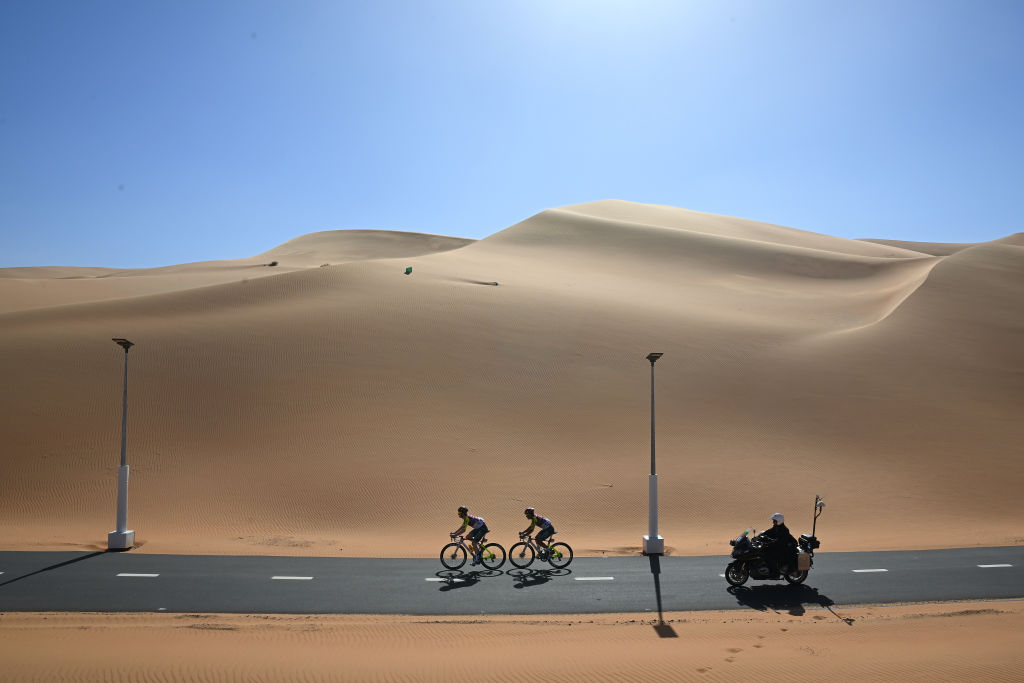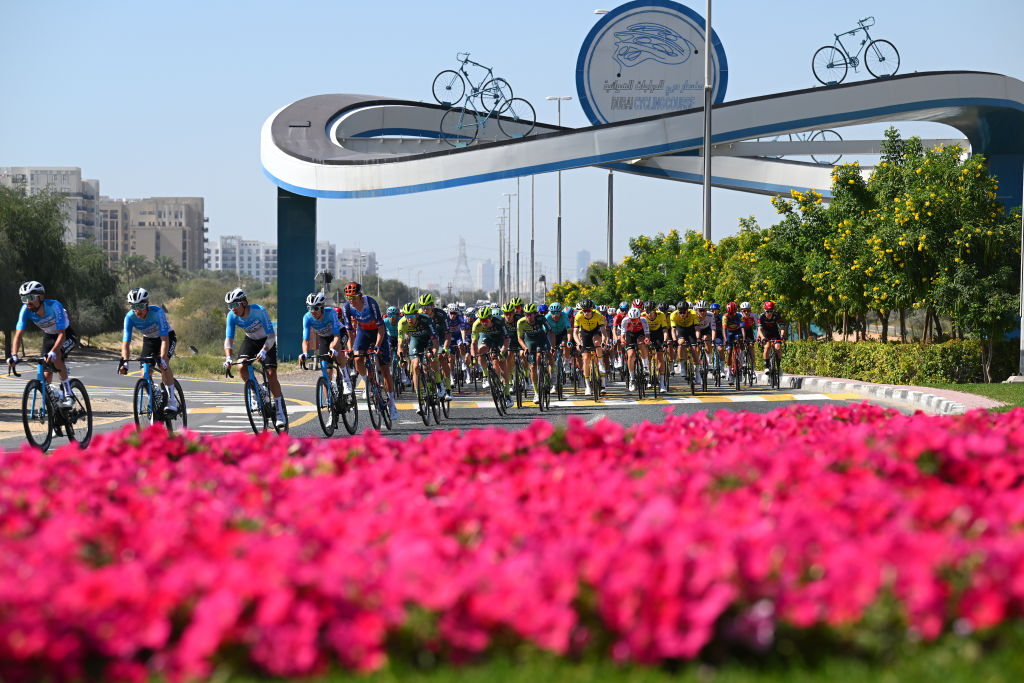What is cycling like in the UAE beyond the WorldTour races?
Local pro cyclist and expats talk about their experiences cycling in the Emirates

In the United Arab Emirates, the car is king – driving a car (or getting driven in a taxi) is by far the easiest and most convenient way to get around the sprawling cityscapes of Abu Dhabi or Dubai. Despite that, there is a growing cycling scene beyond the WorldTour races, and Cyclingnews spoke about the experience of cycling in the UAE to local pro cyclist Safiya Al-Sayegh (UAE Team ADQ) as well as two expats living in Abu Dhabi.
“We have really good facilities here for people wanting to join cycling; the whole experience really motivates you to get into the sport. It all goes back to excellent leadership, supporting all types of sports and supporting cycling. After COVID-19, it’s actually really grown,” Al-Sayegh says.
In 2021, Abu Dhabi received the UCI’s “Bike City” label and was awarded the 2022 and 2024 Urban Cycling World Championships and the 2028 Gran Fondo World Championships, with the 2028 Road World Championships and 2029 Track World Championships awarded in 2023.
For the latter, there are plans for a velodrome with a capacity of 3,500 spectators. Construction hasn’t even started yet, but the facility is projected to open in 2025. On top of the velodrome (literally so), there will be an outdoor cycling track on the roof, accessible by a 600-metre ramp winding around the building.
The network of bike paths in Abu Dhabi is expected to be more than doubled in length in the coming decade, including a fully segregated “Abu Dhabi Loop” of 109 kilometres.
Public bike share schemes also exist, though it’s unclear just how much these share bikes are actually used given the ever-present car traffic and the long distances within the sprawling city of Abu Dhabi – unlike Al-Ain, the Emirati city that feels the most to still be on a human scale, where people are using bikes to get around.
All in all, cycling in the UAE isn’t so much everyday cycling as a mode of transport as it is cycling as a sport. This is not all that surprising in a country where the mean daily minimum temperatures are between 25°C and 30°C for half the year.
Get The Leadout Newsletter
The latest race content, interviews, features, reviews and expert buying guides, direct to your inbox!
There are several car-free cycling tracks in Abu Dhabi, Dubai, Al-Ain and elsewhere for cyclists to ride and train on. One of them is on Al-Hudayriyat Island, just west of Abu Dhabi’s main island. Its 28 kilometres encircle the future site of the velodrome and was the venue of the men’s UAE Tour stage 2 time trial.
The area also features the clubhouse of Abu Dhabi Cycling Club – the fanciest clubhouse you’ll ever set foot in – bike rental, a branch of Wolfi’s bike shop and a shop of the UAE-owned Colnago bike brand. The whole island is being developed as a sports venue for cycling and surfing, including a whole yet-to-be-constructed suburb for those who can afford it. Similar cycling tracks exist in Dubai, and the Yas Marina F1 Circuit is open to cyclists twice a week. Further inland, there is the 40-kilometre Al-Wathba track and the Al-Qudra track.
“You can do more than 100 kilometres without riding past the same point, it’s a whole cycling track across the sand dunes. You sometimes see deer, antelopes, or gazelles up close,” Al-Sayegh tells of her training rides through the desert.
Cycling safest on purpose-built tracks

The modus operandi for these purpose-built bike tracks is to drive there by car with your race bike in the boot of your car (more often than not an SUV), ride around the track, shower at the excellent facilities, and then drive back home. An exception to this rule is Viktor Sitalo, a Russian who came to Abu Dhabi in 2023 and now works at the Wolfi’s High Performance Centre in the Abu Dhabi Cycling Club clubhouse.
“There are bike lanes in the city, but some of them aren’t constructed very well. You’re always crossing major streets and you will sometimes spend two minutes just waiting for the green light. I’m living on Al-Reem Island on the opposite side of the city, and I can ride my bike through the Corniche using bike lanes without any problems,” he explains his commute of about 20 kilometres.
When not using segregated bike paths or purpose-built tracks, though, cycling can be dangerous.
“Now that I am a professional, I do go out on the roads, but I try not to go as much because there’s always that danger. If we ride out of Dubai for some hills and mountains, we will have a backup car with us just for extra safety,” Al-Sayegh explains.
Laurens Bodes, a South African who has been working as a parachute instructor with the UAE Armed Forces for four years and is an amateur triathlete in for a bike fit with Sitalo, concurs.
“We’ve got group rides that we do every Saturday and Sunday morning, but then we’ve got a car behind the group. If you start riding without a car around to look out for you, no,” he says.
Bodes also highlights that the speed limits are often treated as more of a recommendation.
“In Dubai, if they say 120, you can go 140, if they say 140, you can go 160. But here in Abu Dhabi, they are very strict,” he says.
“Compared to Europe, many people don’t have that much knowledge of how to deal with cyclists, so you always have to be careful. There is also a rule that you’re not allowed to ride on roads with a speed limit above 80 km/h; you actually get your bike taken away. That’s fair enough because it’s for your own safety,” Al-Sayegh points out the drivers’ lack of experience with cyclists, a sentiment Sitalo and Bodes share.
For the UAE, then, there are things to improve upon, but the local authorities are pushing hard for cycling to grow, both at the elite level with landmark events like WorldTour races and World Championships and for the local scene of expats and Emiratis who enjoy the sport on a more recreational level.
“It’s not like the cycling industry is growing naturally around well-known community places. Instead, community places are being developed here and then something grows around it. I think the idea is to create these areas where you can cycle safely and maybe connect them all up later,” Sitalo opines.
Lukas Knöfler started working in cycling communications in 2013 and has seen the inside of the scene from many angles. Having worked as press officer for teams and races and written for several online and print publications, he has been Cyclingnews’ Women’s WorldTour correspondent since 2018.